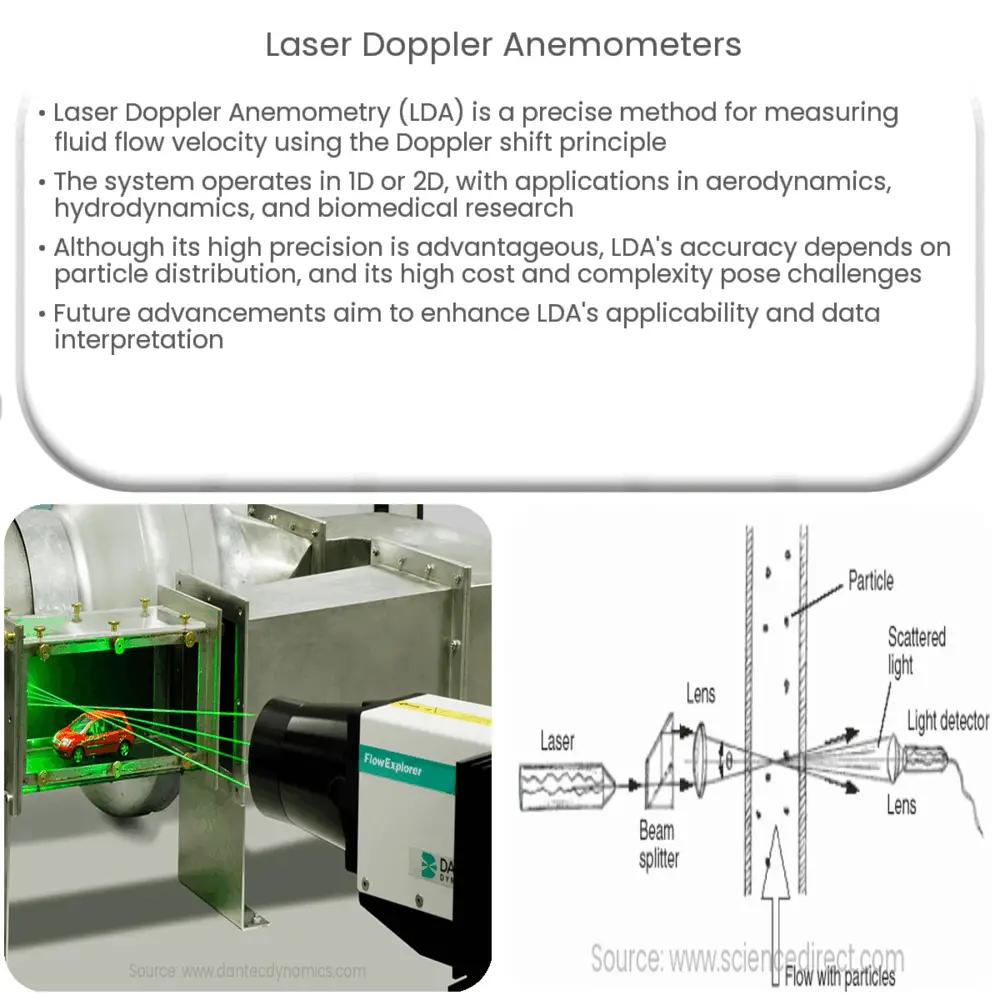Explore the principle, types, applications, pros & cons of Laser Doppler Anemometry, a crucial tool for precise fluid flow measurement.

Laser Doppler Anemometry: A Precision Tool for Fluid Flow Measurement
Laser Doppler Anemometry (LDA), also known as Laser Doppler Velocimetry (LDV), is a highly precise technique used for accurately measuring fluid flow velocity. A powerful tool, LDA provides non-intrusive measurements that are both versatile and robust, capable of operating under various environmental conditions.
The Basic Principle of LDA
At the heart of LDA lies the principle of the Doppler Effect. When light strikes a moving particle, the light frequency changes, a phenomenon known as the Doppler shift. LDA leverages this principle to measure the velocity of particles suspended in a fluid medium.
Working of Laser Doppler Anemometry
-
The LDA system begins with the generation of a laser beam. This beam is then split into two equal intensity beams traveling in different paths.
-
The split beams are focused onto a single point within the fluid, forming an interference pattern of alternating bright and dark regions. These regions are formed due to the constructive and destructive interference of the laser beams.
-
When particles suspended in the fluid flow through the interference region, they scatter light at a frequency proportional to their velocity. The scattered light is detected and processed to provide the velocity of the fluid.
Types of Laser Doppler Anemometry
There are two primary types of LDA: One-dimensional (1D) and Two-dimensional (2D) systems.
-
One-Dimensional LDA: This system measures velocity along a single axis. The major advantage of 1D LDA is its simplicity and the ability to capture high-frequency data. However, it’s limited by its inability to measure multi-directional flows.
-
Two-Dimensional LDA: The 2D LDA systems measure velocities in two perpendicular directions. While these systems are more complex, they offer a more comprehensive understanding of fluid flow, capturing the intricacies of multi-directional flows.
Applications of Laser Doppler Anemometry
LDA’s high precision and non-intrusive nature make it desirable in various sectors. It’s extensively used in aerodynamics, hydrodynamics, and biomedical research. For instance, in aerodynamics, LDA is employed to analyze air flow around aircraft wings or wind turbine blades. Additionally, in hydrodynamics, it’s useful for studying turbulent flows in rivers and oceans. Furthermore, in the biomedical field, LDA is used to measure blood flow in human veins and arteries.
Advantages and Limitations of Laser Doppler Anemometry
Like any measurement technique, Laser Doppler Anemometry has its own set of advantages and limitations, which should be considered for its successful implementation.
Advantages
-
Non-Intrusiveness: LDA doesn’t interfere with the flow field during measurements, ensuring the system maintains the flow’s natural state.
-
High Precision: LDA provides highly accurate velocity measurements, especially for turbulent flows, making it an invaluable tool in fluid mechanics research.
-
Applicability: It can be used for both transparent and opaque fluids, allowing for a wide range of applications.
Limitations
-
Particle Dependency: LDA’s accuracy is heavily dependent on the particles in the fluid medium. Inaccuracies in particle distribution or size can affect the precision of the measurements.
-
Cost and Complexity: LDA systems are expensive and require a high degree of technical knowledge for operation and data interpretation.
-
Limitations in Flow Fields: LDA struggles with flows that have large velocity gradients, as these can cause errors in velocity measurements.
Future of Laser Doppler Anemometry
The future of LDA appears promising with ongoing advancements in laser technologies and digital processing systems. Researchers are continuously working to improve its accuracy and applicability across a broader range of conditions. Innovations in the field, such as the introduction of Three-Dimensional LDA systems, aim to provide more comprehensive flow data, while developments in digital signal processing technologies promise to enhance data analysis and interpretation.
Conclusion
In conclusion, Laser Doppler Anemometry serves as a powerful tool for measuring fluid flow velocity, offering high precision and versatility. Despite its limitations, its ability to perform non-intrusive measurements has seen it employed in a wide range of applications, from aerodynamics to biomedical research. With ongoing advancements in laser and digital technologies, the utility and effectiveness of LDA are poised to only increase, shaping the future of fluid dynamics research.

